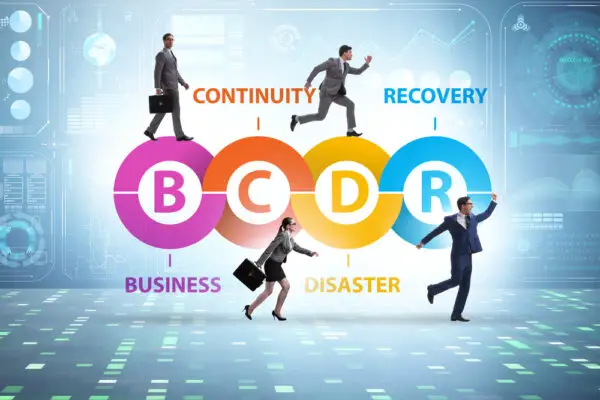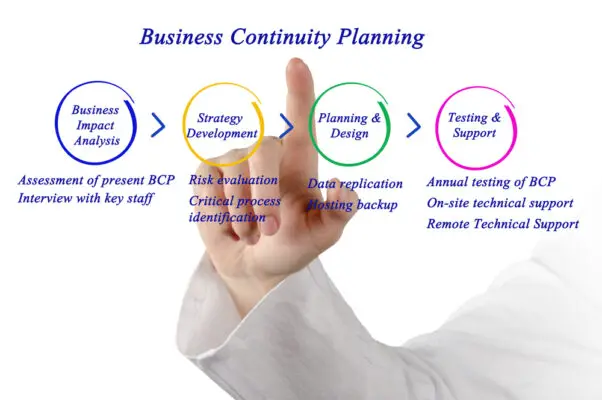A Business Continuity Plan (BCP) ensures critical functions continue during and after a disaster. A well-designed BCP can help minimize downtime, mitigate financial loss, and reduce the impact of disruptions. Here are the key elements that should be included in a BCP:
Purpose, Scope, and Objectives: This section defines the plan’s purpose, the parts of the organization it covers, and the objectives it aims to achieve.
Roles and Responsibilities: Outline who executes each part of the plan. This includes a succession plan that outlines who will step in if key leaders are unavailable.
Key Business Areas and Critical Functions: Identify which functions are critical for the business to keep running. This could include operations, IT services, human resources, and more.
Business Impact Analysis (BIA): This analysis identifies the effects of disruption to business functions. It can help to determine strategy by looking at recovery time objectives (RTOs) and recovery point objectives (RPOs).
Risk Assessment: Identify potential threats and risks, their likelihood, and potential impact. This could include natural disasters, cyber-attacks, pandemics, etc.
Prevention and Mitigation Strategies: Detail the strategies that will be used to prevent, respond to, and recover from a disruption.
Recovery Strategies and Contingency Plans: Outline the steps needed to recover critical business functions, restore operations, and provide for business continuity.
Communication Plan: Define how you’ll communicate with employees, suppliers, customers, and other stakeholders during a disruption. This should also include emergency contact details.
Training and Testing Procedures: Include a training plan for staff to understand their roles in the plan and regular testing procedures to ensure the plan is effective and up-to-date.
Review and Update Schedule: Business continuity plans should be living documents. Include a schedule for reviewing and updating the plan, especially after significant business changes, tests, or real-world events.
Document Locations and Access: The plan needs to be easily accessible to those who require it. Indicate where copies of the plan are stored and how to access them.
The goal of a BCP is to minimize disruption and ensure rapid recovery. It should be comprehensive, clear, and regularly updated to reflect changing circumstances and lessons learned from testing and actual incidents.
Business continuity planning is an essential aspect of risk management for any organization. It involves a set of strategies and procedures to ensure the continued functioning of critical business operations during and after an unplanned disruption or disaster.
Considering its size, structure, and industry, this plan should suit the organization’s needs.
The components of a business continuity plan (BCP) are diverse and include data recovery, productivity strategies, communication guidelines, and contingency plans for natural disasters, among others.
The primary goal of BCP is to minimize downtime after a disaster strikes while safeguarding the organization’s assets, such as data and equipment. Therefore, it is crucial to have a detailed plan that outlines clear steps to mitigate potential threats and recover from disruptions effectively.
This article will discuss what should be included in a business continuity plan so that organizations can adequately prepare themselves for unforeseen events.

Key Takeaways
- Business continuity planning is critical for keeping a company operational and data secure during unplanned disruptions.
- A business continuity plan should include clear communication guidelines for staff, suppliers, and customers, means of contacting important parties, prioritization of critical business operations, and a specific plan for handling natural disasters.
- Testing and review of the plan are crucial for ensuring its effectiveness and should be conducted annually, with input from all departments and business units.
- A solid business continuity plan can positively affect a company’s reputation and market value and increase customer confidence.
What is it?
It is a document that outlines procedures and instructions for maintaining critical business functions during a major disruption. It includes a disaster recovery plan to restore IT infrastructure and operations after a crisis. The plan must be reviewed and updated annually to ensure effectiveness through testing.
The benefits of having a business continuity plan are numerous. It reduces downtime, which can lead to harm, losses, or damage. Failure to react quickly can have severe consequences for an organization.
Therefore, it is essential to prepare for potential risks by conducting risk assessments, identifying critical processes, and implementing strategies that protect critical components.
The preparation process involves several key elements, such as analyzing critical functions, prioritizing severe risks, developing strategies to protect those components, testing the plan’s effectiveness through evidence-based methods like dashboards and reports, and monitoring controls over time while connecting departmental efforts into one comprehensive whole.
Working with professional risk consultants can help create customized BCPs tailored to business needs.
Components of a BCP
The critical components of a comprehensive business continuity strategy typically involve identifying crucial functions, prioritizing severe risks, implementing protection strategies, testing evidence-based solutions, and monitoring dashboards and reports to uncover challenges.
Risk assessment is a significant component of the planning process as it helps identify potential threats that could disrupt business operations.
Once identified, businesses must prioritize critical functions based on their importance and allocate resources accordingly.
Emergency response is another essential part of the BCP. Businesses must develop an emergency response plan that outlines communication protocols during a crisis. The plan should include contact information for key personnel and partners, including vendors and suppliers.
Recovery strategies are also integral to the BCP; businesses must implement measures to restore normal operations immediately after an incident.
Developing a comprehensive business continuity plan involves identifying critical functions, assessing risks, creating an emergency response plan with clear communication guidelines, implementing recovery strategies, and regularly testing the effectiveness of these measures through simulations and reviews.
A well-designed BCP can help minimize downtime during a crisis by enabling organizations to respond quickly while reducing damage or losses. Working with professional risk consultants or using specialized software, such as LogicManager’s ERM solution package for BCP development and its free checklist download, can effectively support designing customized plans tailored to specific organizational needs.
Designing a BCP
Developing a comprehensive business continuity plan (BCP) involves a series of steps, including identifying critical processes, assessing risks, implementing mitigations and recovery strategies, and coordinating departmental efforts. The BCP should be designed to help maintain critical operations during and after a crisis.
One important step is analyzing critical functions to identify the assets, systems, and people necessary for maintaining operations.
Risk analysis is another crucial aspect of creating a BCP. Assessment tools can aid in identifying potential threats that may disrupt business operations, such as natural disasters or cyber-attacks. Mitigation strategies should also be developed to minimize the impact of these risks on essential business functions.
Departmental coordination is important in ensuring all employees know their roles during an emergency. Regularly reporting patterns can help monitor the effectiveness of these measures over time.
Developing and regularly updating a comprehensive BCP is crucial for any organization’s success in reducing downtime after a disaster or crisis.
Following the steps outlined above, organizations can effectively prioritize critical functions while minimizing potential disruptions caused by unforeseen events. Additionally, working with professional risk consultants or utilizing software solutions like LogicManager can further aid in creating customized plans tailored to specific organizational needs.
Importance of BCP
Ensuring operational resilience and minimizing potential disruptions caused by unforeseen events are critical for any organization’s success, highlighting the importance of a comprehensive business continuity strategy.
The cost of downtime can be detrimental to a company’s financial stability, with SMBs losing up to $100,000 an hour due to infrastructure failure or unexpected disasters. Risk assessment is necessary to identify potential threats and their impact on critical business operations, helping organizations develop strategies to protect essential components.
Disaster recovery is integral to any business continuity plan, providing guidelines for restoring IT infrastructure and operations after a crisis. Quick reaction time is crucial in mitigating losses and preventing harm from occurring.
Professional assistance can also aid in creating a customized BCP that addresses specific business needs while ensuring compliance with industry regulations and standards.
To emphasize the importance of a well-planned BCP, the following table displays the potential consequences of not having one in place:
| Consequences Without BCP |
|---|
| Financial loss due to extended downtime |
| Damage to reputation and loss of customer trust |
| Legal liabilities resulting from non-compliance |
| Difficulty securing future investments or partnerships |
Every organization must prioritize developing a comprehensive business continuity plan that identifies critical functions, assesses risks, implements mitigations, monitors controls, connects departmental efforts, and reports patterns over time.
Disaster recovery guidelines should be included in this plan since quick reaction time is essential in mitigating losses and minimizing damage. Professional assistance may also help ensure optimal protection while adhering to industry standards and regulations.
Testing and Review
Testing and reviewing a business continuity strategy should be conducted regularly to ensure its effectiveness in a disaster. Emergency evacuation drills and disaster simulation testing can help identify gaps or lapses in the information that must be addressed. Soliciting feedback from staff is also important to incorporate into the plan before conducting a review.
To engage the audience, here are some best practices for testing and reviewing a business continuity plan:
- Conduct annual emergency evacuation drills to ensure all employees know what to do in an emergency.
- Schedule yearly disaster simulation exercises to test your organization’s readiness for unexpected events.
- Involve new employees in these exercises to detect gaps or lapses in information.
- Incorporate feedback from staff members participating in past simulations into future simulations.
Challenges with testing and reviewing include time constraints, lack of resources, and apathy toward planning. However, the benefits of regular testing and review far outweigh the challenges.
A solid business continuity plan can positively affect an organization’s reputation and market value and increase customer confidence. Employee involvement is key as they are often on the front lines during times of crisis.
Organizations can ensure that their plans remain effective over time by conducting regular tests and reviews.

Frequently Asked Questions
How often should a business continuity plan be updated?
The frequency of updating a business continuity plan is important to ensure its effectiveness in the event of a major disruption.
A thorough review process should be conducted annually, incorporating lessons from past disasters and testing techniques. Significance metrics should be used to measure the plan’s success.
What are some common mistakes made when designing a BCP?
Designing for disasters requires careful consideration of potential mistakes, such as inadequate resource allocation, failure to test scenarios, unclear communication protocols, and neglecting recovery phases. Thorough planning and regular updates can mitigate these risks and ensure a successful business continuity plan.
How can a BCP improve a company’s reputation and market value?
A well-designed business continuity plan (BCP) can improve a company’s reputation and market value by demonstrating preparedness, mitigating risk, enhancing trust, ensuring readiness, and boosting confidence. This can increase customer loyalty and investor confidence in the organization’s ability to weather unexpected disruptions.
What industries outside of IT and finance can benefit from a BCP?
Industries such as Manufacturing Efficiency, Healthcare Operations, Retail Operations, Supply Chain Management, and Hospitality Services can benefit from a business continuity plan. It helps in minimizing downtime and reducing losses caused by disasters or disruptions.
How can a professional risk consultant assist in the development of a BCP?
A professional risk consultant can assist in developing a business continuity plan through comprehensive risk assessment, stakeholder engagement, scenario planning, resource allocation, and documentation review. Their expertise ensures the plan is tailored to specific business needs and effectively addresses potential disruptions.

Conclusion
A business continuity plan is crucial to any organization’s disaster preparedness strategy. It outlines specific measures during an unplanned disruption, ensuring critical operations continue with minimal downtime.
A well-designed BCP should prioritize data recovery, productivity strategies, and communication guidelines tailored to the organization’s needs.
The importance of having a comprehensive BCP in place cannot be overstated. Disasters can strike anytime without warning and have disastrous consequences for unprepared businesses. With a robust BCP, businesses can minimize downtime and safeguard their data.
Testing and review are essential components of an effective BCP. Regularly testing and updating the plan ensures its effectiveness in real-world scenarios while accounting for organizational changes or external factors that may impact operations.

Chris Ekai is a Risk Management expert with over 10 years of experience in the field. He has a Master’s(MSc) degree in Risk Management from University of Portsmouth and is a CPA and Finance professional. He currently works as a Content Manager at Risk Publishing, writing about Enterprise Risk Management, Business Continuity Management and Project Management.

